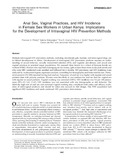| dc.description.abstract | Multiple intravaginal HIV prevention methods, including microbicide gels, barriers, and intravaginal rings, are
in clinical development in Africa. Development of intravaginal HIV prevention products requires an understanding
of sexual behavior, sexually transmitted infection (STI), and vaginitis prevalences, and sexual and
vaginal practices in potential target populations. We assessed these factors in a cohort of Kenyan female sex
workers (FSW). Women who reported exchanging sex for money/gifts at least three times in the past month and
who were HIV uninfected were enrolled and followed for 6 months. STI prevalence and HIV incidence were
analyzed by multivariate logistic regression analysis, controlling for demographic and behavioral factors. Thirtyseven
percent (74/200) reported having had anal sex. Frequency of anal sex was higher with regular and casual
partners than with primary partners. Women were less likely to use condoms for anal sex than for vaginal sex
with regular or casual partners. Vaginal washing was universal (100%). HIV incidence was 5.6 per 100 personyears
(95% CI 1.62, 11.67). HIV incidence was not associated with any demographic or risk behavior. The
relatively high rate of anal sex and universal vaginal washing may complicate both safety and efficacy evaluation
of intravaginal products and should be taken into account in trial design. This FSW population had
significant HIV incidence and needs continued HIV prevention interventions. | en |

